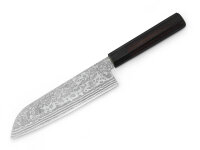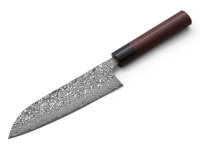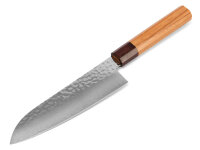"Damascus knife Bunka 170 White Ebony, 35 layers"
Hiroshi Kato - a true master of Japanese knives
He is the second master blacksmith and knife maker in the family. He learned the fine art of forging knives of exceptionally high quality from his father, Kintaro Kato. Traditionally, this was the usual way in which the skills and \"secrets\" of the masters were passed on. Traditions played an important role for Hiroschi Kato, but he is also a person of change. As a co-initiator, together with other master blacksmiths, he founded the knife village Takefu with the aim of preserving the old knowledge, exchanging experiences and passing them on to young blacksmiths. One of the boys was Yoshimi Kato, son and successor of Hiroshi, who is now also one of the masters. Hirosho Kato, today, after almost 60 years of work, mostly rests the blacksmith's hammer and is mainly responsible for quality, further development and training. in 2008, Hiroshi Kato became the second knifemaker to receive the Certificate of Traditional Craftsmen, a high distinction for excellence in craftsmanship.
Yoshimi Kato White Ebony Knife Series
Material: The chef's knife series Damascus Knife White Ebony has several distinctive features. There is the unusual handle made of the rare, noble white ebony, with its strong color contrasts. And of course the finish with the special fine surface grind and the hammered blade. Built up, the blade is made of 34 layers of Damascus steel with two different degrees of hardness, alternately layered around the core of VG-10 steel. VG-10 is a Japanese high performance steel that is particularly characterized by high hardness, very good flexibility and its corrosion resistance. The wear resistance and the resistance of the sharpness of this cooking fair are excellent, the steel is easy to sharpen. The HRC value, measure of the hardness of the steel, is 61. VG-10 is a stainless steel and, unlike carbon steels Aogami or Shirogami, contains about 15% chromium. The sheath consists of 16 layers of harder and 18 slightly softer nickel damascus. So that hardness, sharpness and the reasonable elasticity are in an excellent ratio to each other. Finish: Visually, the blade is dominated on the one hand by the Damascus layers, on the other - in the upper area - by the hammering. Before the blade is hammered, Yoshimi finishes the blade surface with a particularly fine grind. In test, it has been found that the angular, special style of the hammering supports the non-stick effect for cut material very well. Handle: The handle of these knives is made of high-quality, rare ebony wood. This is also the reason why these knives can only be produced in very small editions. But not only the wood, also the shape of the handle has an \"extra\". The small depression near the end of the handle, gives more grip and optimizes the guidance of the knife. Especially when there are large pieces to cut, this shape brings even more in terms of safety and control over the sharp blade.
How to use
Japanese chef's knives are made of extremely hard steels and are forged and ground thinner than their European counterparts. Some of these knives have very finely ground cutting layers, making them more delicate and suitable only for soft cut foods. Please refer to the product details for information in this regard. In particular, knives with a very thin cutting edge and hollow grind are prone to chipping on the blade. These are excellent for fine cuts of soft cut material, but should be used with appropriate care. Sharpening on a whetstone usually produces an angled grind, which makes the edge more stable over time.
Breakouts on the cutting edge can also be caused by leverage forces as well as frozen cuttings, which significantly reduce the temperature of the steel. Leverage forces often occur when cutting material with bones, for example. Chipping on the cutting edge may need to be ground out by a professional.
The knife should always be guided straight with pulling or pushing cut, without much pressure. To maintain sharpness, avoid cutting on stone, glass or other hard surfaces. Never use \"sharpening steel\" for resharpening. Water sharpening stones are recommended (grit: 400-1200 for preliminary sharpening, 3000 for fine sharpening, 6000 or more to strip the blade) and a honing leather if necessary.
Please keep the knife away from children. These knives are extremely sharp, please be careful.
All products are unique, so slight deviations from the exemplary picture are possible.
Care instructions
When using knives made of delicate steel types, such as Aogami, Shirogami or V-Toku, please clean them occasionally with a cloth and water even during prolonged use. However, acidic foods can still cause discoloration on these classic carbon steels. After use, please wash by hand with hot water and use a neutral detergent if necessary. Please do not put the knife in the dishwasher under any circumstances. After cleaning, dry thoroughly, oil if necessary, and store in a well-ventilated area. Residual moisture can cause rust in non-stainless steels. See our posts on the ORYOKI Japan blog for product care.
Clean the knife by hand and do not use a dishwasher. Dry it thoroughly afterwards.





















